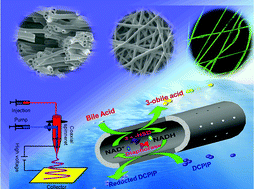Enabling multi-enzyme biocatalysis using coaxial-electrospun hollow nanofibers: redesign of artificial cells
Abstract
Highly efficient immobilization of multi-enzyme systems involving cofactor regeneration represents one of the greatest challenges in bioprocessing. Particulate artificial cells with enzymes and cofactors encapsulated within microcapsules have long been the major type of multi-enzyme biocatalysts. In the present work, a novel hollow nanofiber-based artificial cell that performs multi-step reactions involving efficient coenzyme regeneration was fabricated in situ by a facile co-axial electrospinning process. To that end, a mixture of glycerol and water containing the dissolved multi-enzyme system for the bile acid assay, which included 3α-hydroxysteroid dehydrogenase (3α-HSD), diaphorase (DP) and NADH was fed as the core phase solution, and a N,N-dimethylacetylamide solution of 30 wt% polyurethane was fed as the shell phase solution during the co-axial electrospinning. The relationship between the structures of the hollow nanofibers and the activity and stability of the encapsulated enzymes was studied. At core and shell phase electrospinning solution flow rates of 0.07 and 0.5 mL h−1, activity recoveries as high as 76% and 82% were obtained for the encapsulated 3α-HSD and DP. The hollow nanofiber-based artificial cells were successfully used for the bile acid assay, yielding good linearity for bile acid concentrations ranging from 0–200 μM. Compared with the solution-based multi-enzyme system, the hollow nanofiber-based multi-enzyme system presented a lumped activity recovery of 75%. In addition, the hollow nanofiber provided the multi-enzyme system confined inside the nano-domain of the hollow fibers with a unique stabilizing mechanism, such that more than a 170-fold increase in half-life at 25 °C was obtained for the encapsulated 3α-HSD and DP. This study is expected to greatly promote and broaden the application of multi-enzyme systems in industry, biosensor, biomedical, and many other related research fields.


 Please wait while we load your content...
Please wait while we load your content...